Business Strategy Analysis: Vodafone's Macro-Environment Report
VerifiedAdded on 2020/10/23
|13
|4208
|251
Report
AI Summary
This report provides a comprehensive analysis of Vodafone's business strategy, focusing on the impact of the macro-environment. It includes a PESTLE analysis to assess political, economic, social, technological, legal, and environmental factors affecting Vodafone's operations. The report also examines Vodafone's internal environment, strategic capabilities, and the application of the VRIO model to assess its resources. Furthermore, it applies Porter's five forces model to analyze the competitiveness of the UK telecommunications sector and explores strategic directions and options available to the enterprise, including Ansoff's growth matrix. The report aims to provide insights into Vodafone's strategic planning and its approach to achieving a competitive edge and market position.
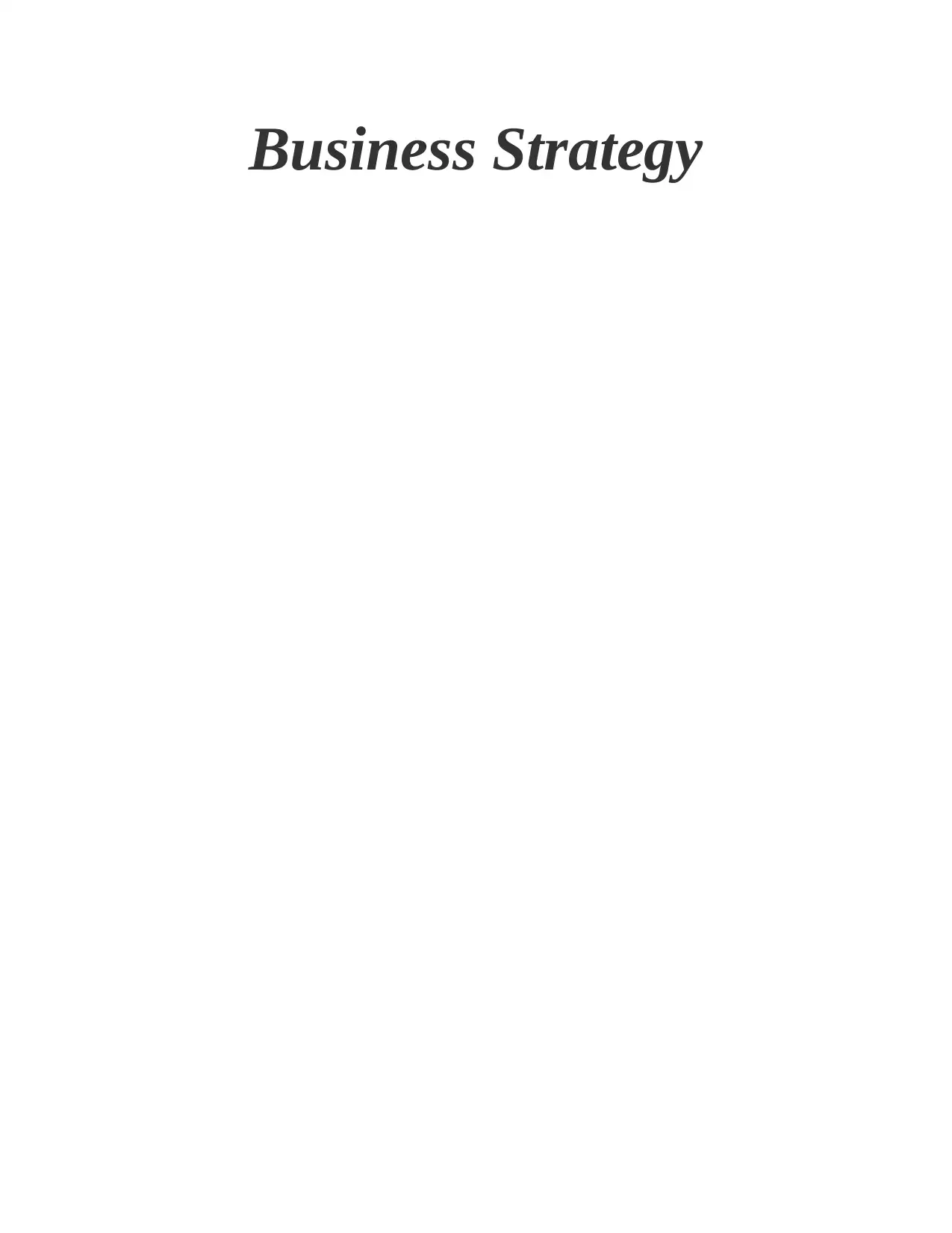
Business Strategy
Paraphrase This Document
Need a fresh take? Get an instant paraphrase of this document with our AI Paraphraser
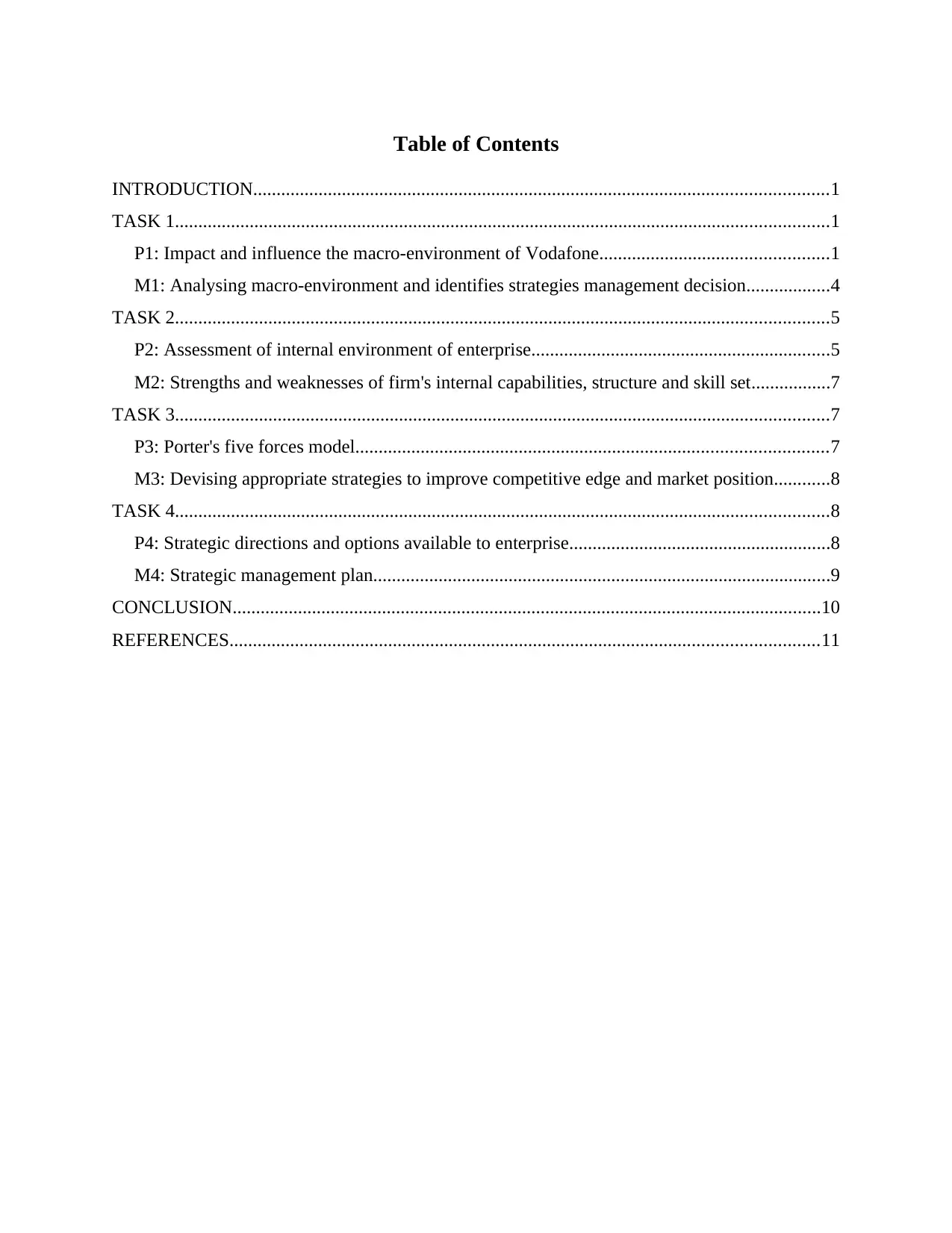
Table of Contents
INTRODUCTION...........................................................................................................................1
TASK 1............................................................................................................................................1
P1: Impact and influence the macro-environment of Vodafone.................................................1
M1: Analysing macro-environment and identifies strategies management decision..................4
TASK 2............................................................................................................................................5
P2: Assessment of internal environment of enterprise................................................................5
M2: Strengths and weaknesses of firm's internal capabilities, structure and skill set.................7
TASK 3............................................................................................................................................7
P3: Porter's five forces model.....................................................................................................7
M3: Devising appropriate strategies to improve competitive edge and market position............8
TASK 4............................................................................................................................................8
P4: Strategic directions and options available to enterprise........................................................8
M4: Strategic management plan..................................................................................................9
CONCLUSION..............................................................................................................................10
REFERENCES..............................................................................................................................11
INTRODUCTION...........................................................................................................................1
TASK 1............................................................................................................................................1
P1: Impact and influence the macro-environment of Vodafone.................................................1
M1: Analysing macro-environment and identifies strategies management decision..................4
TASK 2............................................................................................................................................5
P2: Assessment of internal environment of enterprise................................................................5
M2: Strengths and weaknesses of firm's internal capabilities, structure and skill set.................7
TASK 3............................................................................................................................................7
P3: Porter's five forces model.....................................................................................................7
M3: Devising appropriate strategies to improve competitive edge and market position............8
TASK 4............................................................................................................................................8
P4: Strategic directions and options available to enterprise........................................................8
M4: Strategic management plan..................................................................................................9
CONCLUSION..............................................................................................................................10
REFERENCES..............................................................................................................................11
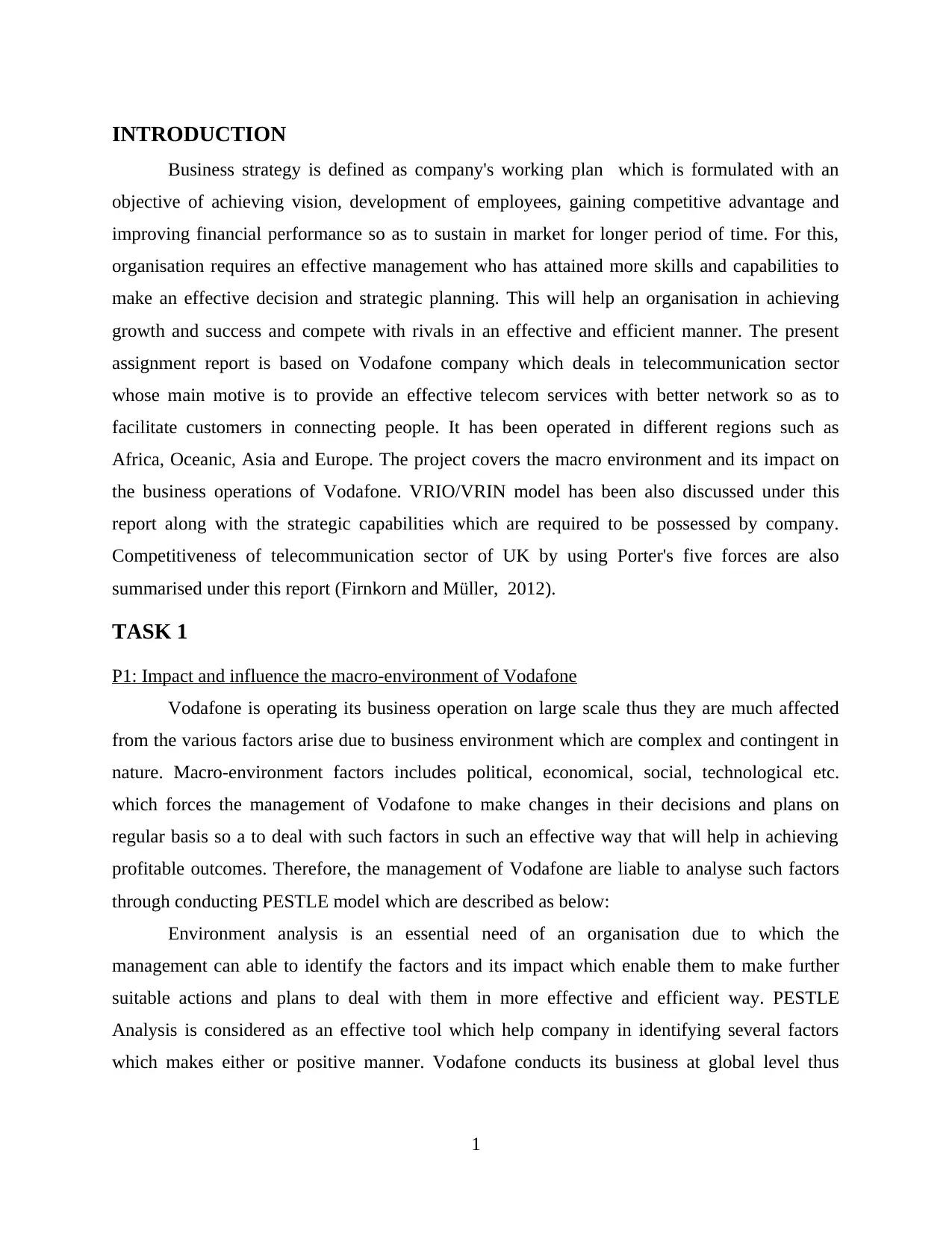
INTRODUCTION
Business strategy is defined as company's working plan which is formulated with an
objective of achieving vision, development of employees, gaining competitive advantage and
improving financial performance so as to sustain in market for longer period of time. For this,
organisation requires an effective management who has attained more skills and capabilities to
make an effective decision and strategic planning. This will help an organisation in achieving
growth and success and compete with rivals in an effective and efficient manner. The present
assignment report is based on Vodafone company which deals in telecommunication sector
whose main motive is to provide an effective telecom services with better network so as to
facilitate customers in connecting people. It has been operated in different regions such as
Africa, Oceanic, Asia and Europe. The project covers the macro environment and its impact on
the business operations of Vodafone. VRIO/VRIN model has been also discussed under this
report along with the strategic capabilities which are required to be possessed by company.
Competitiveness of telecommunication sector of UK by using Porter's five forces are also
summarised under this report (Firnkorn and Müller, 2012).
TASK 1
P1: Impact and influence the macro-environment of Vodafone
Vodafone is operating its business operation on large scale thus they are much affected
from the various factors arise due to business environment which are complex and contingent in
nature. Macro-environment factors includes political, economical, social, technological etc.
which forces the management of Vodafone to make changes in their decisions and plans on
regular basis so a to deal with such factors in such an effective way that will help in achieving
profitable outcomes. Therefore, the management of Vodafone are liable to analyse such factors
through conducting PESTLE model which are described as below:
Environment analysis is an essential need of an organisation due to which the
management can able to identify the factors and its impact which enable them to make further
suitable actions and plans to deal with them in more effective and efficient way. PESTLE
Analysis is considered as an effective tool which help company in identifying several factors
which makes either or positive manner. Vodafone conducts its business at global level thus
1
Business strategy is defined as company's working plan which is formulated with an
objective of achieving vision, development of employees, gaining competitive advantage and
improving financial performance so as to sustain in market for longer period of time. For this,
organisation requires an effective management who has attained more skills and capabilities to
make an effective decision and strategic planning. This will help an organisation in achieving
growth and success and compete with rivals in an effective and efficient manner. The present
assignment report is based on Vodafone company which deals in telecommunication sector
whose main motive is to provide an effective telecom services with better network so as to
facilitate customers in connecting people. It has been operated in different regions such as
Africa, Oceanic, Asia and Europe. The project covers the macro environment and its impact on
the business operations of Vodafone. VRIO/VRIN model has been also discussed under this
report along with the strategic capabilities which are required to be possessed by company.
Competitiveness of telecommunication sector of UK by using Porter's five forces are also
summarised under this report (Firnkorn and Müller, 2012).
TASK 1
P1: Impact and influence the macro-environment of Vodafone
Vodafone is operating its business operation on large scale thus they are much affected
from the various factors arise due to business environment which are complex and contingent in
nature. Macro-environment factors includes political, economical, social, technological etc.
which forces the management of Vodafone to make changes in their decisions and plans on
regular basis so a to deal with such factors in such an effective way that will help in achieving
profitable outcomes. Therefore, the management of Vodafone are liable to analyse such factors
through conducting PESTLE model which are described as below:
Environment analysis is an essential need of an organisation due to which the
management can able to identify the factors and its impact which enable them to make further
suitable actions and plans to deal with them in more effective and efficient way. PESTLE
Analysis is considered as an effective tool which help company in identifying several factors
which makes either or positive manner. Vodafone conducts its business at global level thus
1
⊘ This is a preview!⊘
Do you want full access?
Subscribe today to unlock all pages.

Trusted by 1+ million students worldwide
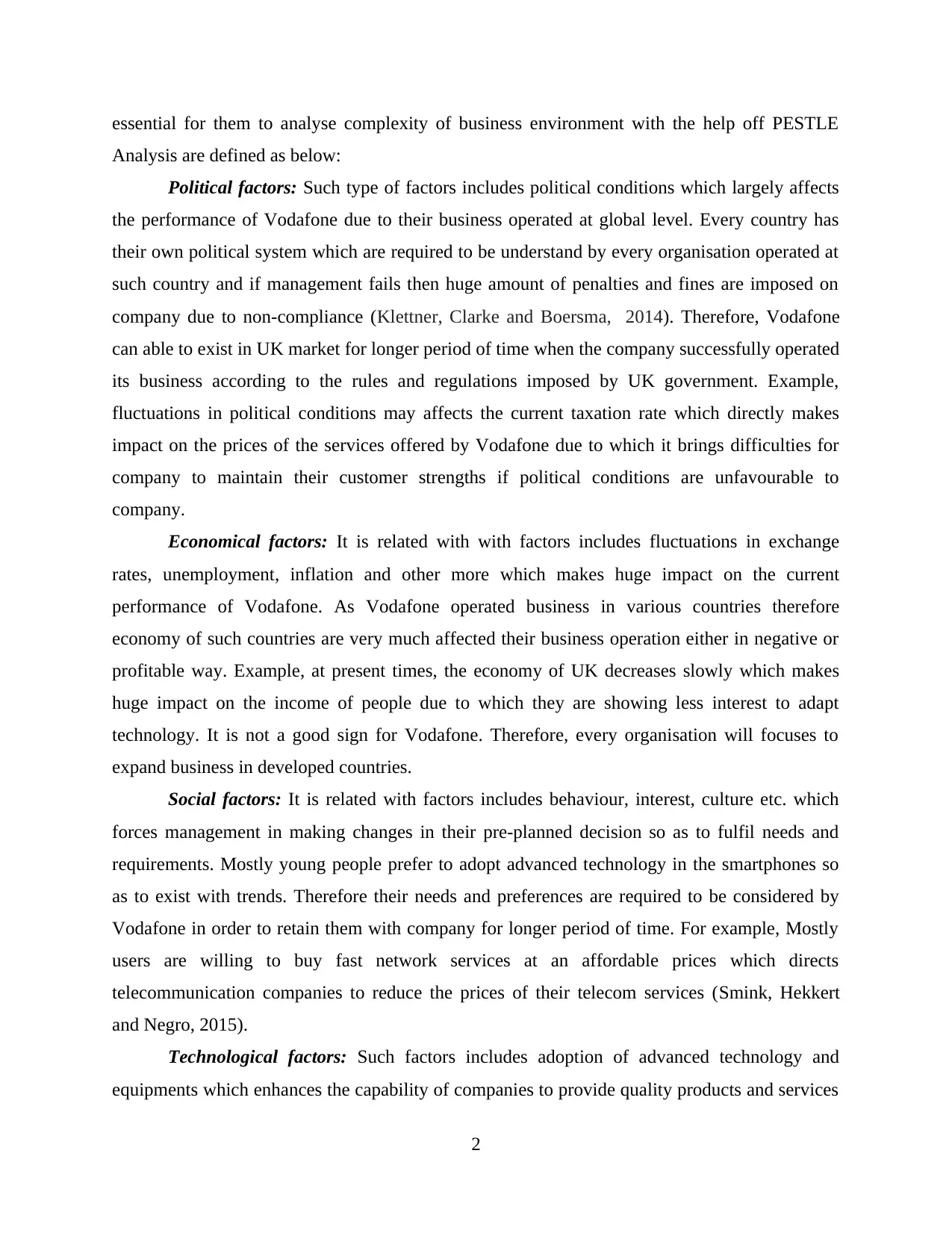
essential for them to analyse complexity of business environment with the help off PESTLE
Analysis are defined as below:
Political factors: Such type of factors includes political conditions which largely affects
the performance of Vodafone due to their business operated at global level. Every country has
their own political system which are required to be understand by every organisation operated at
such country and if management fails then huge amount of penalties and fines are imposed on
company due to non-compliance (Klettner, Clarke and Boersma, 2014). Therefore, Vodafone
can able to exist in UK market for longer period of time when the company successfully operated
its business according to the rules and regulations imposed by UK government. Example,
fluctuations in political conditions may affects the current taxation rate which directly makes
impact on the prices of the services offered by Vodafone due to which it brings difficulties for
company to maintain their customer strengths if political conditions are unfavourable to
company.
Economical factors: It is related with with factors includes fluctuations in exchange
rates, unemployment, inflation and other more which makes huge impact on the current
performance of Vodafone. As Vodafone operated business in various countries therefore
economy of such countries are very much affected their business operation either in negative or
profitable way. Example, at present times, the economy of UK decreases slowly which makes
huge impact on the income of people due to which they are showing less interest to adapt
technology. It is not a good sign for Vodafone. Therefore, every organisation will focuses to
expand business in developed countries.
Social factors: It is related with factors includes behaviour, interest, culture etc. which
forces management in making changes in their pre-planned decision so as to fulfil needs and
requirements. Mostly young people prefer to adopt advanced technology in the smartphones so
as to exist with trends. Therefore their needs and preferences are required to be considered by
Vodafone in order to retain them with company for longer period of time. For example, Mostly
users are willing to buy fast network services at an affordable prices which directs
telecommunication companies to reduce the prices of their telecom services (Smink, Hekkert
and Negro, 2015).
Technological factors: Such factors includes adoption of advanced technology and
equipments which enhances the capability of companies to provide quality products and services
2
Analysis are defined as below:
Political factors: Such type of factors includes political conditions which largely affects
the performance of Vodafone due to their business operated at global level. Every country has
their own political system which are required to be understand by every organisation operated at
such country and if management fails then huge amount of penalties and fines are imposed on
company due to non-compliance (Klettner, Clarke and Boersma, 2014). Therefore, Vodafone
can able to exist in UK market for longer period of time when the company successfully operated
its business according to the rules and regulations imposed by UK government. Example,
fluctuations in political conditions may affects the current taxation rate which directly makes
impact on the prices of the services offered by Vodafone due to which it brings difficulties for
company to maintain their customer strengths if political conditions are unfavourable to
company.
Economical factors: It is related with with factors includes fluctuations in exchange
rates, unemployment, inflation and other more which makes huge impact on the current
performance of Vodafone. As Vodafone operated business in various countries therefore
economy of such countries are very much affected their business operation either in negative or
profitable way. Example, at present times, the economy of UK decreases slowly which makes
huge impact on the income of people due to which they are showing less interest to adapt
technology. It is not a good sign for Vodafone. Therefore, every organisation will focuses to
expand business in developed countries.
Social factors: It is related with factors includes behaviour, interest, culture etc. which
forces management in making changes in their pre-planned decision so as to fulfil needs and
requirements. Mostly young people prefer to adopt advanced technology in the smartphones so
as to exist with trends. Therefore their needs and preferences are required to be considered by
Vodafone in order to retain them with company for longer period of time. For example, Mostly
users are willing to buy fast network services at an affordable prices which directs
telecommunication companies to reduce the prices of their telecom services (Smink, Hekkert
and Negro, 2015).
Technological factors: Such factors includes adoption of advanced technology and
equipments which enhances the capability of companies to provide quality products and services
2
Paraphrase This Document
Need a fresh take? Get an instant paraphrase of this document with our AI Paraphraser
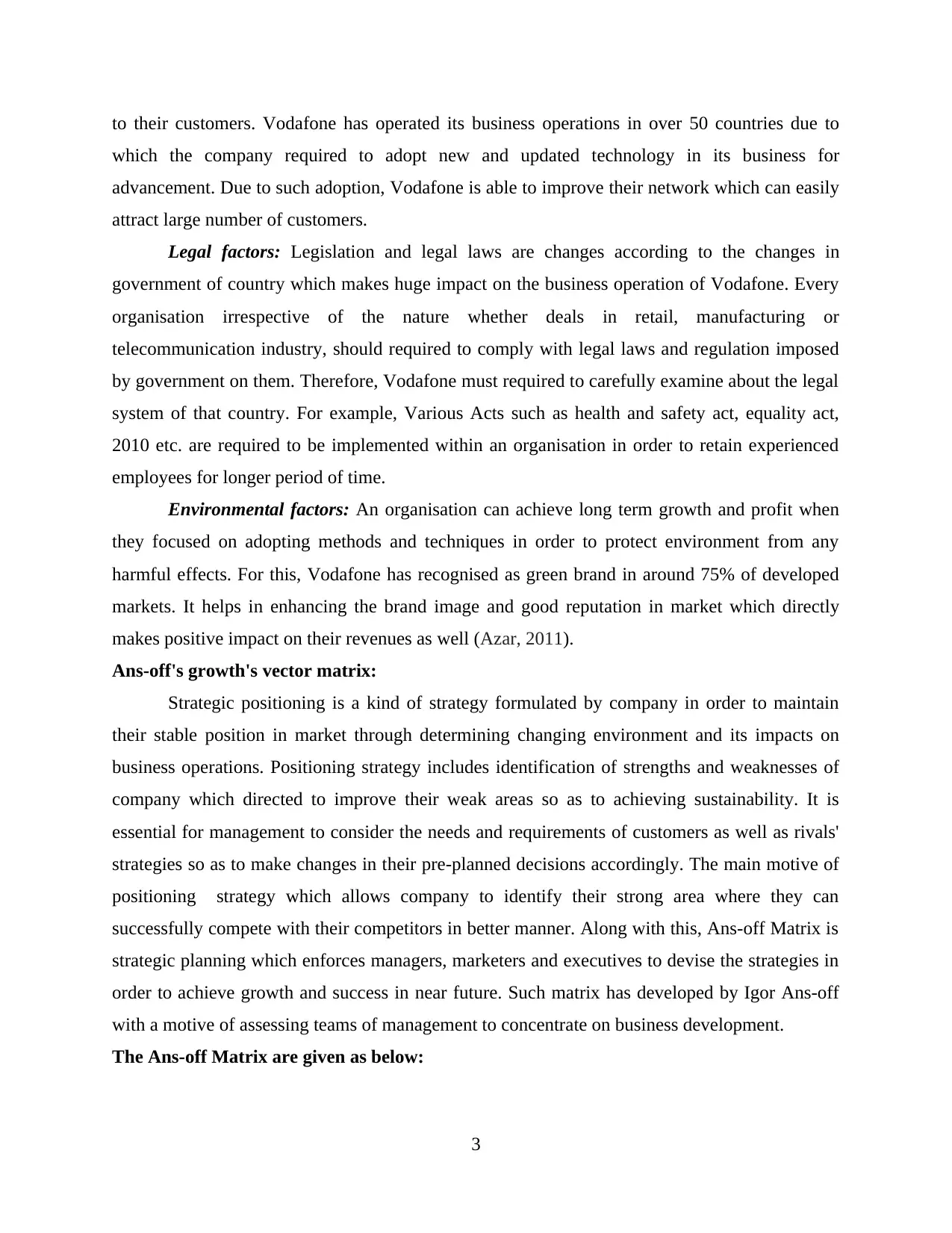
to their customers. Vodafone has operated its business operations in over 50 countries due to
which the company required to adopt new and updated technology in its business for
advancement. Due to such adoption, Vodafone is able to improve their network which can easily
attract large number of customers.
Legal factors: Legislation and legal laws are changes according to the changes in
government of country which makes huge impact on the business operation of Vodafone. Every
organisation irrespective of the nature whether deals in retail, manufacturing or
telecommunication industry, should required to comply with legal laws and regulation imposed
by government on them. Therefore, Vodafone must required to carefully examine about the legal
system of that country. For example, Various Acts such as health and safety act, equality act,
2010 etc. are required to be implemented within an organisation in order to retain experienced
employees for longer period of time.
Environmental factors: An organisation can achieve long term growth and profit when
they focused on adopting methods and techniques in order to protect environment from any
harmful effects. For this, Vodafone has recognised as green brand in around 75% of developed
markets. It helps in enhancing the brand image and good reputation in market which directly
makes positive impact on their revenues as well (Azar, 2011).
Ans-off's growth's vector matrix:
Strategic positioning is a kind of strategy formulated by company in order to maintain
their stable position in market through determining changing environment and its impacts on
business operations. Positioning strategy includes identification of strengths and weaknesses of
company which directed to improve their weak areas so as to achieving sustainability. It is
essential for management to consider the needs and requirements of customers as well as rivals'
strategies so as to make changes in their pre-planned decisions accordingly. The main motive of
positioning strategy which allows company to identify their strong area where they can
successfully compete with their competitors in better manner. Along with this, Ans-off Matrix is
strategic planning which enforces managers, marketers and executives to devise the strategies in
order to achieve growth and success in near future. Such matrix has developed by Igor Ans-off
with a motive of assessing teams of management to concentrate on business development.
The Ans-off Matrix are given as below:
3
which the company required to adopt new and updated technology in its business for
advancement. Due to such adoption, Vodafone is able to improve their network which can easily
attract large number of customers.
Legal factors: Legislation and legal laws are changes according to the changes in
government of country which makes huge impact on the business operation of Vodafone. Every
organisation irrespective of the nature whether deals in retail, manufacturing or
telecommunication industry, should required to comply with legal laws and regulation imposed
by government on them. Therefore, Vodafone must required to carefully examine about the legal
system of that country. For example, Various Acts such as health and safety act, equality act,
2010 etc. are required to be implemented within an organisation in order to retain experienced
employees for longer period of time.
Environmental factors: An organisation can achieve long term growth and profit when
they focused on adopting methods and techniques in order to protect environment from any
harmful effects. For this, Vodafone has recognised as green brand in around 75% of developed
markets. It helps in enhancing the brand image and good reputation in market which directly
makes positive impact on their revenues as well (Azar, 2011).
Ans-off's growth's vector matrix:
Strategic positioning is a kind of strategy formulated by company in order to maintain
their stable position in market through determining changing environment and its impacts on
business operations. Positioning strategy includes identification of strengths and weaknesses of
company which directed to improve their weak areas so as to achieving sustainability. It is
essential for management to consider the needs and requirements of customers as well as rivals'
strategies so as to make changes in their pre-planned decisions accordingly. The main motive of
positioning strategy which allows company to identify their strong area where they can
successfully compete with their competitors in better manner. Along with this, Ans-off Matrix is
strategic planning which enforces managers, marketers and executives to devise the strategies in
order to achieve growth and success in near future. Such matrix has developed by Igor Ans-off
with a motive of assessing teams of management to concentrate on business development.
The Ans-off Matrix are given as below:
3
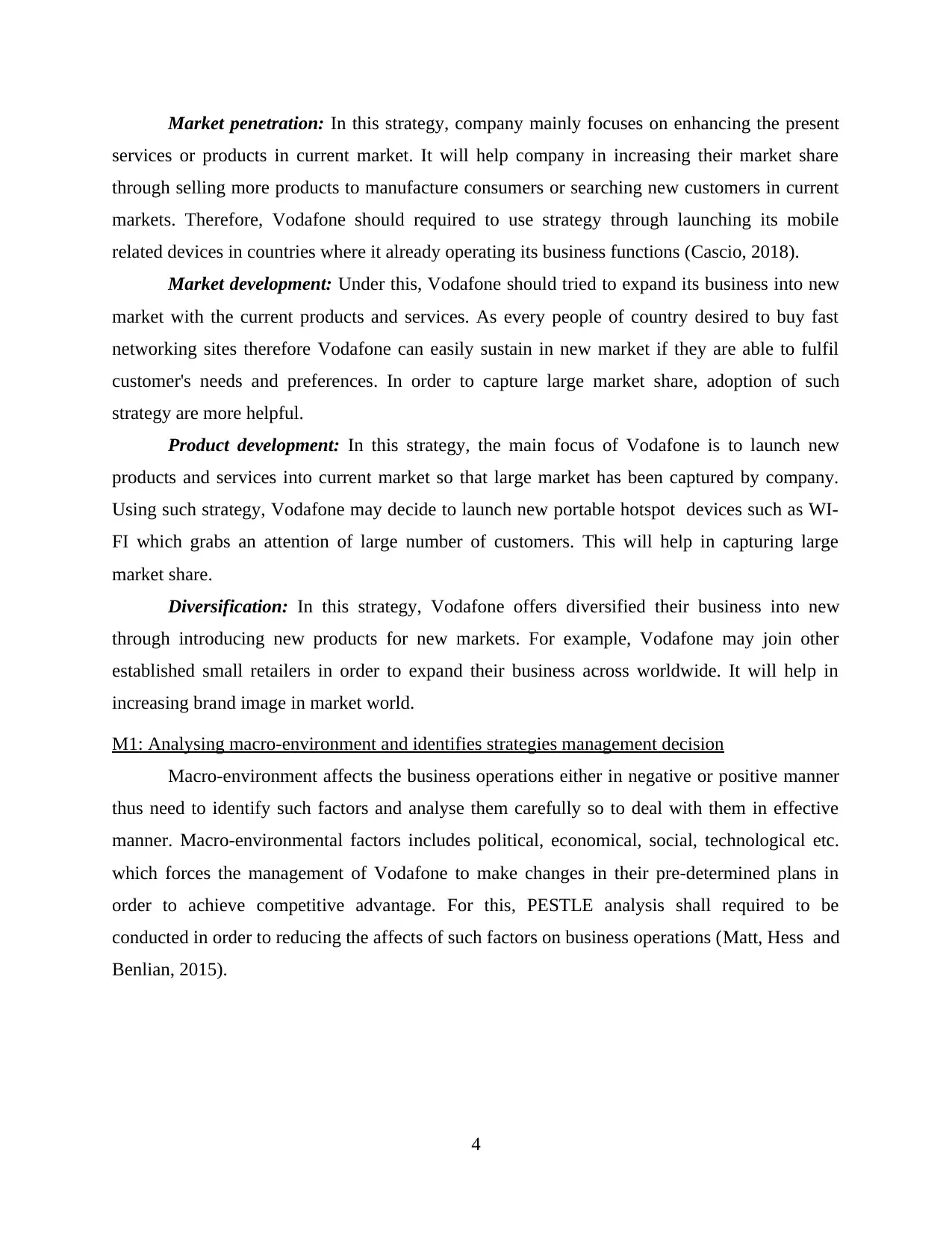
Market penetration: In this strategy, company mainly focuses on enhancing the present
services or products in current market. It will help company in increasing their market share
through selling more products to manufacture consumers or searching new customers in current
markets. Therefore, Vodafone should required to use strategy through launching its mobile
related devices in countries where it already operating its business functions (Cascio, 2018).
Market development: Under this, Vodafone should tried to expand its business into new
market with the current products and services. As every people of country desired to buy fast
networking sites therefore Vodafone can easily sustain in new market if they are able to fulfil
customer's needs and preferences. In order to capture large market share, adoption of such
strategy are more helpful.
Product development: In this strategy, the main focus of Vodafone is to launch new
products and services into current market so that large market has been captured by company.
Using such strategy, Vodafone may decide to launch new portable hotspot devices such as WI-
FI which grabs an attention of large number of customers. This will help in capturing large
market share.
Diversification: In this strategy, Vodafone offers diversified their business into new
through introducing new products for new markets. For example, Vodafone may join other
established small retailers in order to expand their business across worldwide. It will help in
increasing brand image in market world.
M1: Analysing macro-environment and identifies strategies management decision
Macro-environment affects the business operations either in negative or positive manner
thus need to identify such factors and analyse them carefully so to deal with them in effective
manner. Macro-environmental factors includes political, economical, social, technological etc.
which forces the management of Vodafone to make changes in their pre-determined plans in
order to achieve competitive advantage. For this, PESTLE analysis shall required to be
conducted in order to reducing the affects of such factors on business operations (Matt, Hess and
Benlian, 2015).
4
services or products in current market. It will help company in increasing their market share
through selling more products to manufacture consumers or searching new customers in current
markets. Therefore, Vodafone should required to use strategy through launching its mobile
related devices in countries where it already operating its business functions (Cascio, 2018).
Market development: Under this, Vodafone should tried to expand its business into new
market with the current products and services. As every people of country desired to buy fast
networking sites therefore Vodafone can easily sustain in new market if they are able to fulfil
customer's needs and preferences. In order to capture large market share, adoption of such
strategy are more helpful.
Product development: In this strategy, the main focus of Vodafone is to launch new
products and services into current market so that large market has been captured by company.
Using such strategy, Vodafone may decide to launch new portable hotspot devices such as WI-
FI which grabs an attention of large number of customers. This will help in capturing large
market share.
Diversification: In this strategy, Vodafone offers diversified their business into new
through introducing new products for new markets. For example, Vodafone may join other
established small retailers in order to expand their business across worldwide. It will help in
increasing brand image in market world.
M1: Analysing macro-environment and identifies strategies management decision
Macro-environment affects the business operations either in negative or positive manner
thus need to identify such factors and analyse them carefully so to deal with them in effective
manner. Macro-environmental factors includes political, economical, social, technological etc.
which forces the management of Vodafone to make changes in their pre-determined plans in
order to achieve competitive advantage. For this, PESTLE analysis shall required to be
conducted in order to reducing the affects of such factors on business operations (Matt, Hess and
Benlian, 2015).
4
⊘ This is a preview!⊘
Do you want full access?
Subscribe today to unlock all pages.

Trusted by 1+ million students worldwide
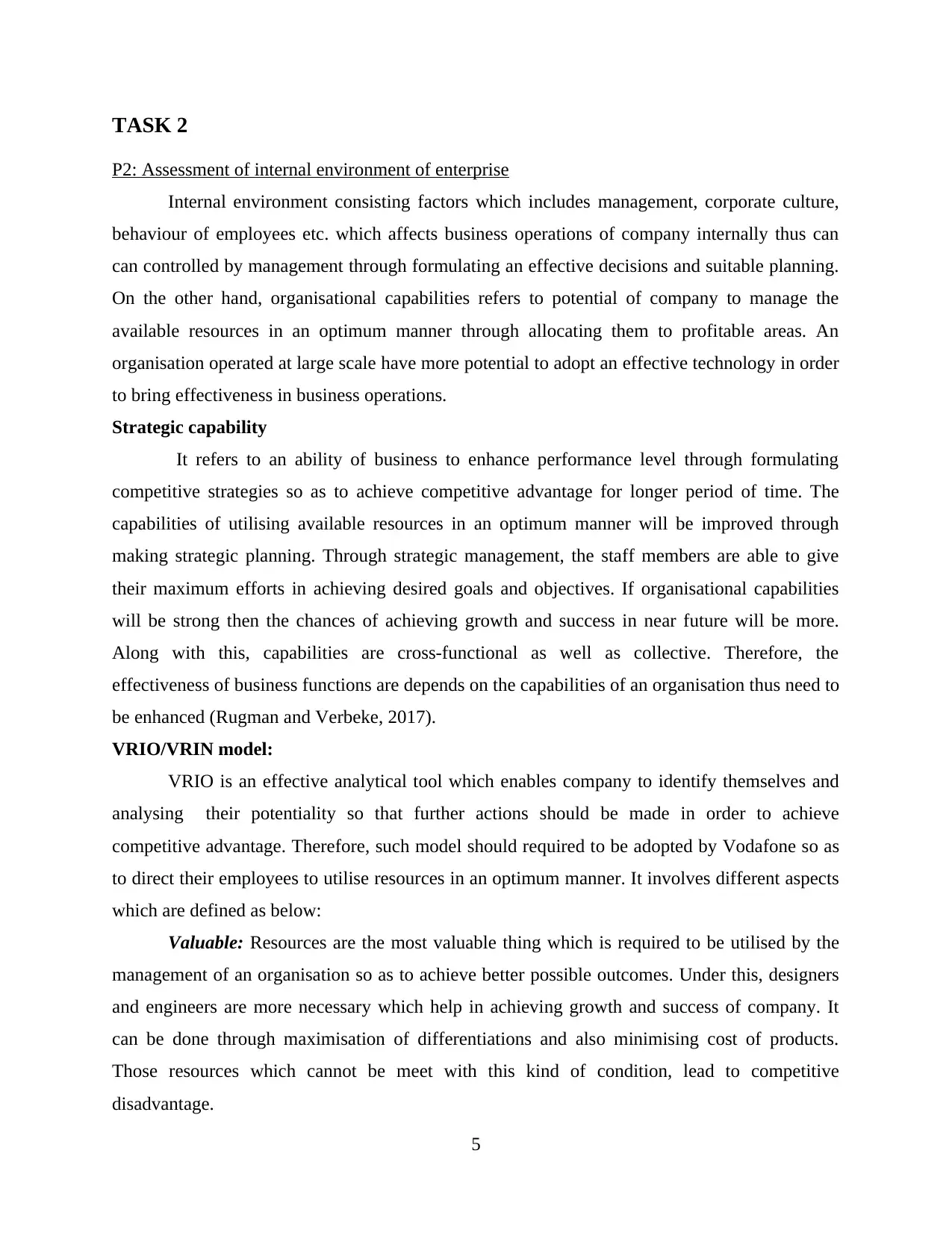
TASK 2
P2: Assessment of internal environment of enterprise
Internal environment consisting factors which includes management, corporate culture,
behaviour of employees etc. which affects business operations of company internally thus can
can controlled by management through formulating an effective decisions and suitable planning.
On the other hand, organisational capabilities refers to potential of company to manage the
available resources in an optimum manner through allocating them to profitable areas. An
organisation operated at large scale have more potential to adopt an effective technology in order
to bring effectiveness in business operations.
Strategic capability
It refers to an ability of business to enhance performance level through formulating
competitive strategies so as to achieve competitive advantage for longer period of time. The
capabilities of utilising available resources in an optimum manner will be improved through
making strategic planning. Through strategic management, the staff members are able to give
their maximum efforts in achieving desired goals and objectives. If organisational capabilities
will be strong then the chances of achieving growth and success in near future will be more.
Along with this, capabilities are cross-functional as well as collective. Therefore, the
effectiveness of business functions are depends on the capabilities of an organisation thus need to
be enhanced (Rugman and Verbeke, 2017).
VRIO/VRIN model:
VRIO is an effective analytical tool which enables company to identify themselves and
analysing their potentiality so that further actions should be made in order to achieve
competitive advantage. Therefore, such model should required to be adopted by Vodafone so as
to direct their employees to utilise resources in an optimum manner. It involves different aspects
which are defined as below:
Valuable: Resources are the most valuable thing which is required to be utilised by the
management of an organisation so as to achieve better possible outcomes. Under this, designers
and engineers are more necessary which help in achieving growth and success of company. It
can be done through maximisation of differentiations and also minimising cost of products.
Those resources which cannot be meet with this kind of condition, lead to competitive
disadvantage.
5
P2: Assessment of internal environment of enterprise
Internal environment consisting factors which includes management, corporate culture,
behaviour of employees etc. which affects business operations of company internally thus can
can controlled by management through formulating an effective decisions and suitable planning.
On the other hand, organisational capabilities refers to potential of company to manage the
available resources in an optimum manner through allocating them to profitable areas. An
organisation operated at large scale have more potential to adopt an effective technology in order
to bring effectiveness in business operations.
Strategic capability
It refers to an ability of business to enhance performance level through formulating
competitive strategies so as to achieve competitive advantage for longer period of time. The
capabilities of utilising available resources in an optimum manner will be improved through
making strategic planning. Through strategic management, the staff members are able to give
their maximum efforts in achieving desired goals and objectives. If organisational capabilities
will be strong then the chances of achieving growth and success in near future will be more.
Along with this, capabilities are cross-functional as well as collective. Therefore, the
effectiveness of business functions are depends on the capabilities of an organisation thus need to
be enhanced (Rugman and Verbeke, 2017).
VRIO/VRIN model:
VRIO is an effective analytical tool which enables company to identify themselves and
analysing their potentiality so that further actions should be made in order to achieve
competitive advantage. Therefore, such model should required to be adopted by Vodafone so as
to direct their employees to utilise resources in an optimum manner. It involves different aspects
which are defined as below:
Valuable: Resources are the most valuable thing which is required to be utilised by the
management of an organisation so as to achieve better possible outcomes. Under this, designers
and engineers are more necessary which help in achieving growth and success of company. It
can be done through maximisation of differentiations and also minimising cost of products.
Those resources which cannot be meet with this kind of condition, lead to competitive
disadvantage.
5
Paraphrase This Document
Need a fresh take? Get an instant paraphrase of this document with our AI Paraphraser
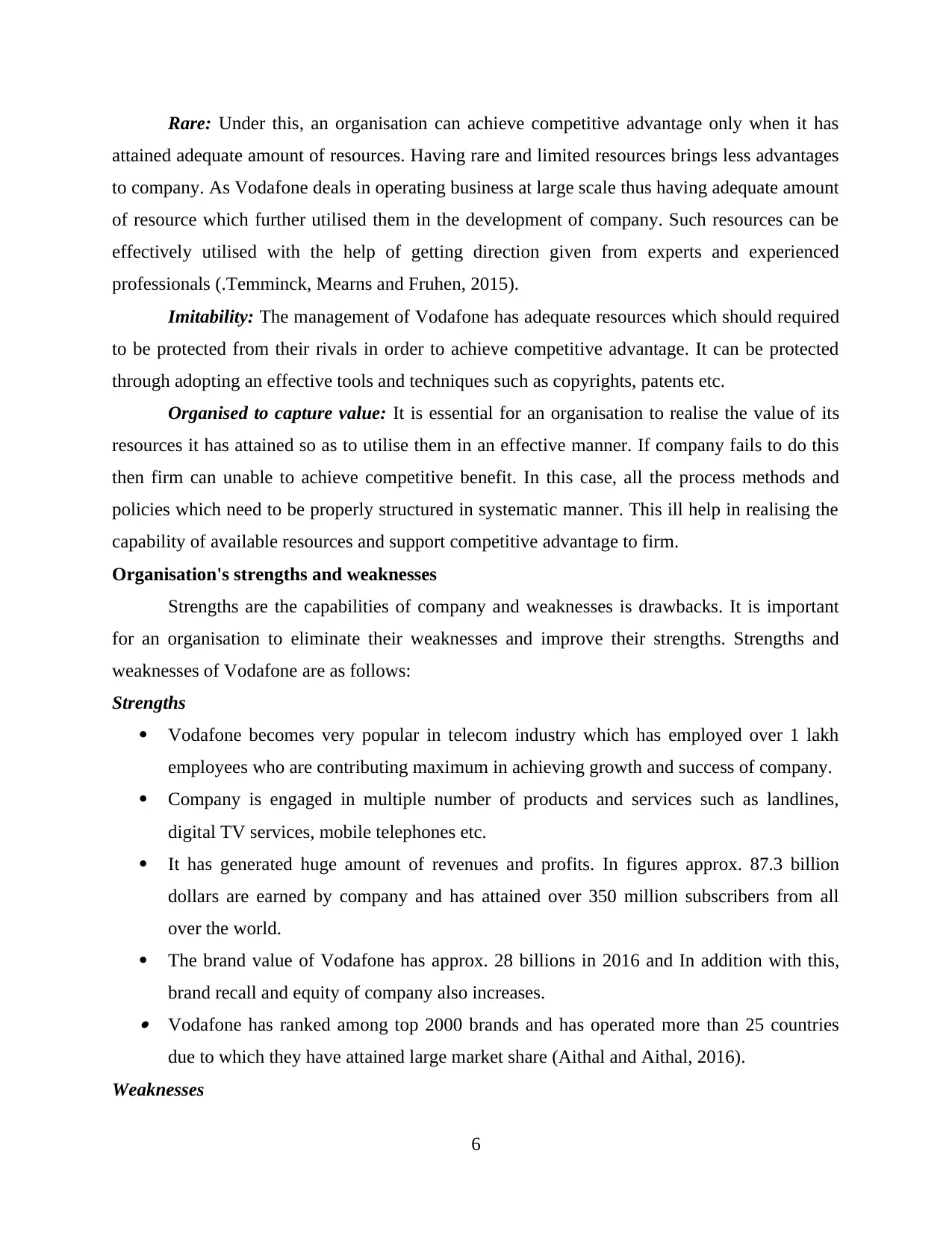
Rare: Under this, an organisation can achieve competitive advantage only when it has
attained adequate amount of resources. Having rare and limited resources brings less advantages
to company. As Vodafone deals in operating business at large scale thus having adequate amount
of resource which further utilised them in the development of company. Such resources can be
effectively utilised with the help of getting direction given from experts and experienced
professionals (.Temminck, Mearns and Fruhen, 2015).
Imitability: The management of Vodafone has adequate resources which should required
to be protected from their rivals in order to achieve competitive advantage. It can be protected
through adopting an effective tools and techniques such as copyrights, patents etc.
Organised to capture value: It is essential for an organisation to realise the value of its
resources it has attained so as to utilise them in an effective manner. If company fails to do this
then firm can unable to achieve competitive benefit. In this case, all the process methods and
policies which need to be properly structured in systematic manner. This ill help in realising the
capability of available resources and support competitive advantage to firm.
Organisation's strengths and weaknesses
Strengths are the capabilities of company and weaknesses is drawbacks. It is important
for an organisation to eliminate their weaknesses and improve their strengths. Strengths and
weaknesses of Vodafone are as follows:
Strengths
Vodafone becomes very popular in telecom industry which has employed over 1 lakh
employees who are contributing maximum in achieving growth and success of company.
Company is engaged in multiple number of products and services such as landlines,
digital TV services, mobile telephones etc.
It has generated huge amount of revenues and profits. In figures approx. 87.3 billion
dollars are earned by company and has attained over 350 million subscribers from all
over the world.
The brand value of Vodafone has approx. 28 billions in 2016 and In addition with this,
brand recall and equity of company also increases. Vodafone has ranked among top 2000 brands and has operated more than 25 countries
due to which they have attained large market share (Aithal and Aithal, 2016).
Weaknesses
6
attained adequate amount of resources. Having rare and limited resources brings less advantages
to company. As Vodafone deals in operating business at large scale thus having adequate amount
of resource which further utilised them in the development of company. Such resources can be
effectively utilised with the help of getting direction given from experts and experienced
professionals (.Temminck, Mearns and Fruhen, 2015).
Imitability: The management of Vodafone has adequate resources which should required
to be protected from their rivals in order to achieve competitive advantage. It can be protected
through adopting an effective tools and techniques such as copyrights, patents etc.
Organised to capture value: It is essential for an organisation to realise the value of its
resources it has attained so as to utilise them in an effective manner. If company fails to do this
then firm can unable to achieve competitive benefit. In this case, all the process methods and
policies which need to be properly structured in systematic manner. This ill help in realising the
capability of available resources and support competitive advantage to firm.
Organisation's strengths and weaknesses
Strengths are the capabilities of company and weaknesses is drawbacks. It is important
for an organisation to eliminate their weaknesses and improve their strengths. Strengths and
weaknesses of Vodafone are as follows:
Strengths
Vodafone becomes very popular in telecom industry which has employed over 1 lakh
employees who are contributing maximum in achieving growth and success of company.
Company is engaged in multiple number of products and services such as landlines,
digital TV services, mobile telephones etc.
It has generated huge amount of revenues and profits. In figures approx. 87.3 billion
dollars are earned by company and has attained over 350 million subscribers from all
over the world.
The brand value of Vodafone has approx. 28 billions in 2016 and In addition with this,
brand recall and equity of company also increases. Vodafone has ranked among top 2000 brands and has operated more than 25 countries
due to which they have attained large market share (Aithal and Aithal, 2016).
Weaknesses
6
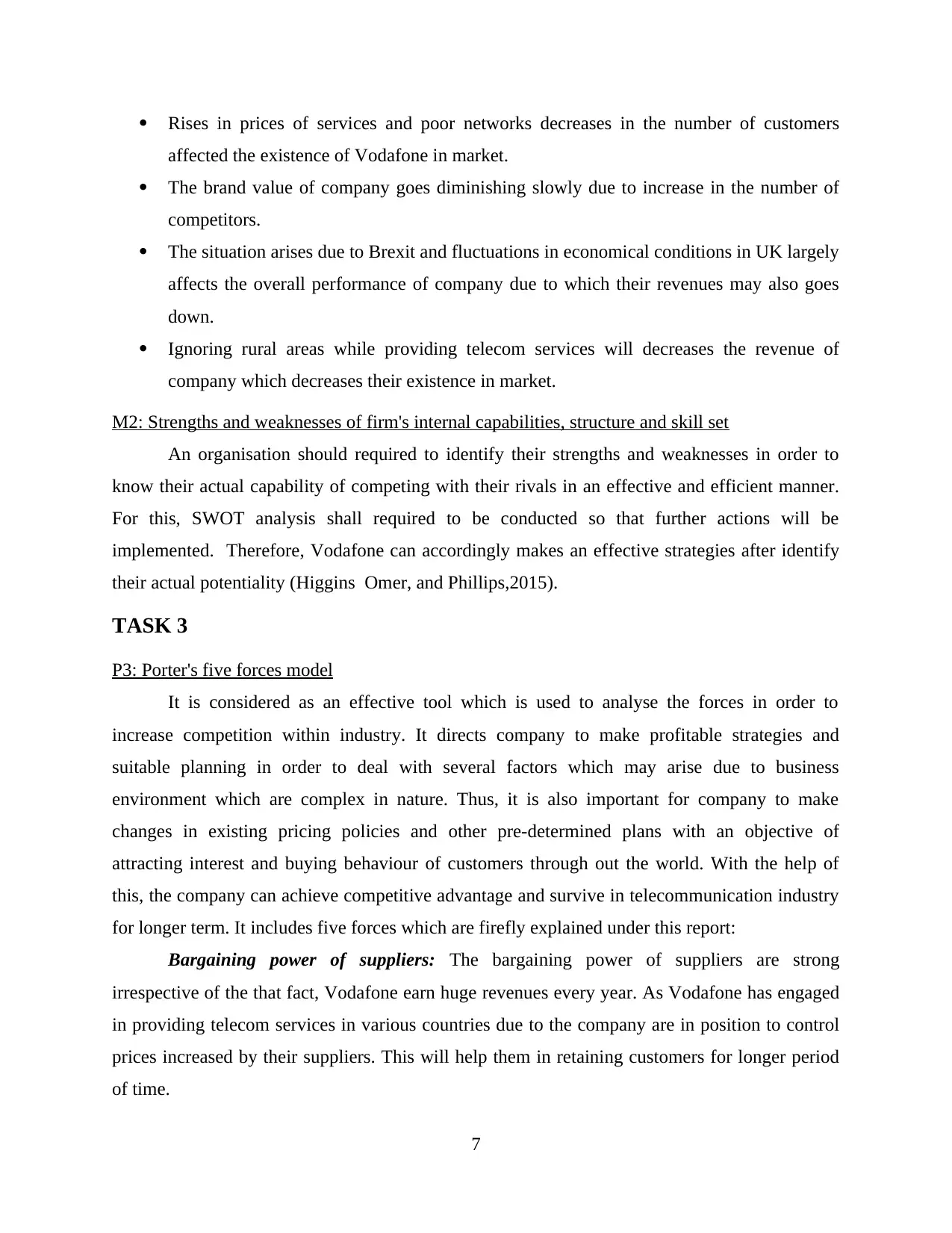
Rises in prices of services and poor networks decreases in the number of customers
affected the existence of Vodafone in market.
The brand value of company goes diminishing slowly due to increase in the number of
competitors.
The situation arises due to Brexit and fluctuations in economical conditions in UK largely
affects the overall performance of company due to which their revenues may also goes
down.
Ignoring rural areas while providing telecom services will decreases the revenue of
company which decreases their existence in market.
M2: Strengths and weaknesses of firm's internal capabilities, structure and skill set
An organisation should required to identify their strengths and weaknesses in order to
know their actual capability of competing with their rivals in an effective and efficient manner.
For this, SWOT analysis shall required to be conducted so that further actions will be
implemented. Therefore, Vodafone can accordingly makes an effective strategies after identify
their actual potentiality (Higgins Omer, and Phillips,2015).
TASK 3
P3: Porter's five forces model
It is considered as an effective tool which is used to analyse the forces in order to
increase competition within industry. It directs company to make profitable strategies and
suitable planning in order to deal with several factors which may arise due to business
environment which are complex in nature. Thus, it is also important for company to make
changes in existing pricing policies and other pre-determined plans with an objective of
attracting interest and buying behaviour of customers through out the world. With the help of
this, the company can achieve competitive advantage and survive in telecommunication industry
for longer term. It includes five forces which are firefly explained under this report:
Bargaining power of suppliers: The bargaining power of suppliers are strong
irrespective of the that fact, Vodafone earn huge revenues every year. As Vodafone has engaged
in providing telecom services in various countries due to the company are in position to control
prices increased by their suppliers. This will help them in retaining customers for longer period
of time.
7
affected the existence of Vodafone in market.
The brand value of company goes diminishing slowly due to increase in the number of
competitors.
The situation arises due to Brexit and fluctuations in economical conditions in UK largely
affects the overall performance of company due to which their revenues may also goes
down.
Ignoring rural areas while providing telecom services will decreases the revenue of
company which decreases their existence in market.
M2: Strengths and weaknesses of firm's internal capabilities, structure and skill set
An organisation should required to identify their strengths and weaknesses in order to
know their actual capability of competing with their rivals in an effective and efficient manner.
For this, SWOT analysis shall required to be conducted so that further actions will be
implemented. Therefore, Vodafone can accordingly makes an effective strategies after identify
their actual potentiality (Higgins Omer, and Phillips,2015).
TASK 3
P3: Porter's five forces model
It is considered as an effective tool which is used to analyse the forces in order to
increase competition within industry. It directs company to make profitable strategies and
suitable planning in order to deal with several factors which may arise due to business
environment which are complex in nature. Thus, it is also important for company to make
changes in existing pricing policies and other pre-determined plans with an objective of
attracting interest and buying behaviour of customers through out the world. With the help of
this, the company can achieve competitive advantage and survive in telecommunication industry
for longer term. It includes five forces which are firefly explained under this report:
Bargaining power of suppliers: The bargaining power of suppliers are strong
irrespective of the that fact, Vodafone earn huge revenues every year. As Vodafone has engaged
in providing telecom services in various countries due to the company are in position to control
prices increased by their suppliers. This will help them in retaining customers for longer period
of time.
7
⊘ This is a preview!⊘
Do you want full access?
Subscribe today to unlock all pages.

Trusted by 1+ million students worldwide
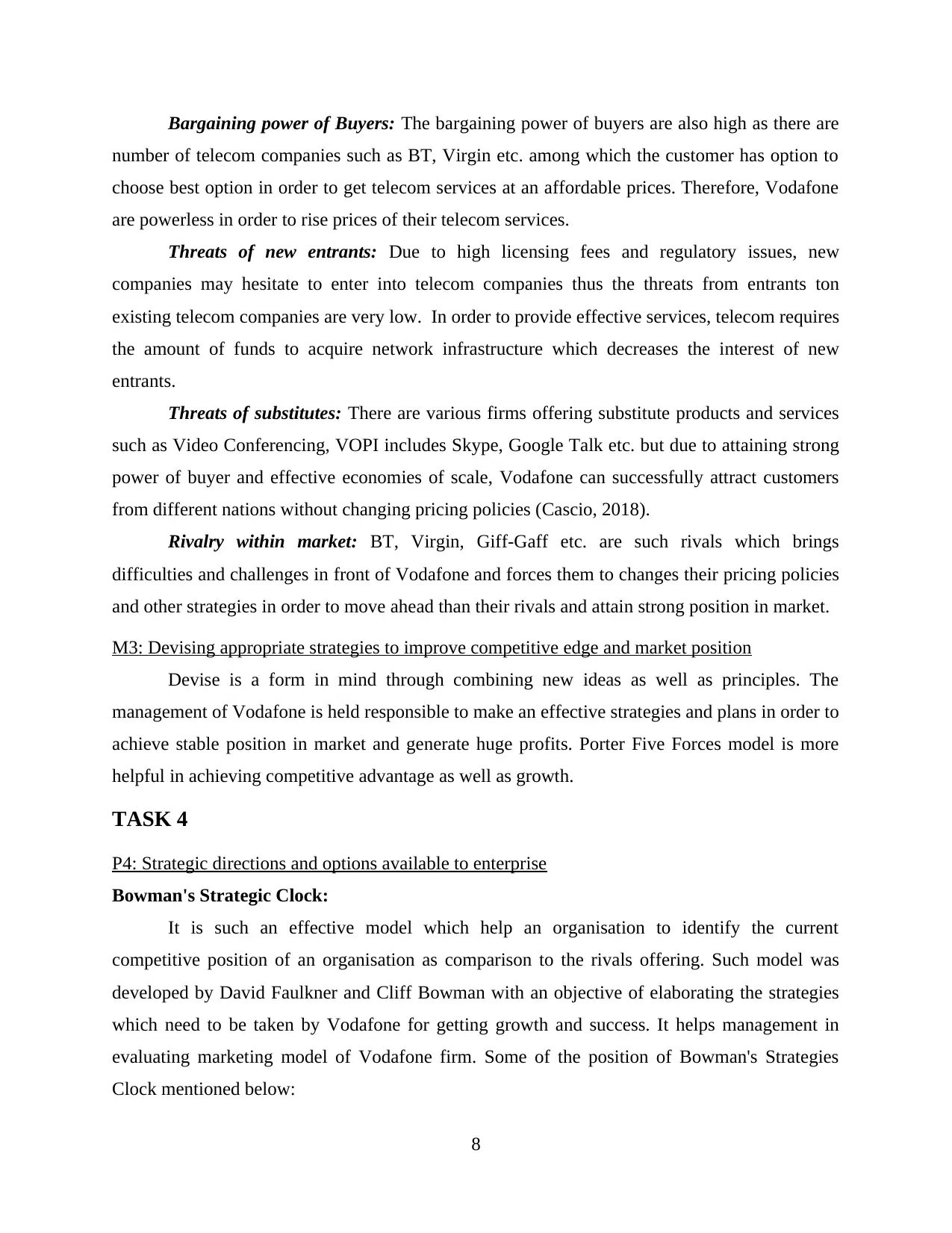
Bargaining power of Buyers: The bargaining power of buyers are also high as there are
number of telecom companies such as BT, Virgin etc. among which the customer has option to
choose best option in order to get telecom services at an affordable prices. Therefore, Vodafone
are powerless in order to rise prices of their telecom services.
Threats of new entrants: Due to high licensing fees and regulatory issues, new
companies may hesitate to enter into telecom companies thus the threats from entrants ton
existing telecom companies are very low. In order to provide effective services, telecom requires
the amount of funds to acquire network infrastructure which decreases the interest of new
entrants.
Threats of substitutes: There are various firms offering substitute products and services
such as Video Conferencing, VOPI includes Skype, Google Talk etc. but due to attaining strong
power of buyer and effective economies of scale, Vodafone can successfully attract customers
from different nations without changing pricing policies (Cascio, 2018).
Rivalry within market: BT, Virgin, Giff-Gaff etc. are such rivals which brings
difficulties and challenges in front of Vodafone and forces them to changes their pricing policies
and other strategies in order to move ahead than their rivals and attain strong position in market.
M3: Devising appropriate strategies to improve competitive edge and market position
Devise is a form in mind through combining new ideas as well as principles. The
management of Vodafone is held responsible to make an effective strategies and plans in order to
achieve stable position in market and generate huge profits. Porter Five Forces model is more
helpful in achieving competitive advantage as well as growth.
TASK 4
P4: Strategic directions and options available to enterprise
Bowman's Strategic Clock:
It is such an effective model which help an organisation to identify the current
competitive position of an organisation as comparison to the rivals offering. Such model was
developed by David Faulkner and Cliff Bowman with an objective of elaborating the strategies
which need to be taken by Vodafone for getting growth and success. It helps management in
evaluating marketing model of Vodafone firm. Some of the position of Bowman's Strategies
Clock mentioned below:
8
number of telecom companies such as BT, Virgin etc. among which the customer has option to
choose best option in order to get telecom services at an affordable prices. Therefore, Vodafone
are powerless in order to rise prices of their telecom services.
Threats of new entrants: Due to high licensing fees and regulatory issues, new
companies may hesitate to enter into telecom companies thus the threats from entrants ton
existing telecom companies are very low. In order to provide effective services, telecom requires
the amount of funds to acquire network infrastructure which decreases the interest of new
entrants.
Threats of substitutes: There are various firms offering substitute products and services
such as Video Conferencing, VOPI includes Skype, Google Talk etc. but due to attaining strong
power of buyer and effective economies of scale, Vodafone can successfully attract customers
from different nations without changing pricing policies (Cascio, 2018).
Rivalry within market: BT, Virgin, Giff-Gaff etc. are such rivals which brings
difficulties and challenges in front of Vodafone and forces them to changes their pricing policies
and other strategies in order to move ahead than their rivals and attain strong position in market.
M3: Devising appropriate strategies to improve competitive edge and market position
Devise is a form in mind through combining new ideas as well as principles. The
management of Vodafone is held responsible to make an effective strategies and plans in order to
achieve stable position in market and generate huge profits. Porter Five Forces model is more
helpful in achieving competitive advantage as well as growth.
TASK 4
P4: Strategic directions and options available to enterprise
Bowman's Strategic Clock:
It is such an effective model which help an organisation to identify the current
competitive position of an organisation as comparison to the rivals offering. Such model was
developed by David Faulkner and Cliff Bowman with an objective of elaborating the strategies
which need to be taken by Vodafone for getting growth and success. It helps management in
evaluating marketing model of Vodafone firm. Some of the position of Bowman's Strategies
Clock mentioned below:
8
Paraphrase This Document
Need a fresh take? Get an instant paraphrase of this document with our AI Paraphraser
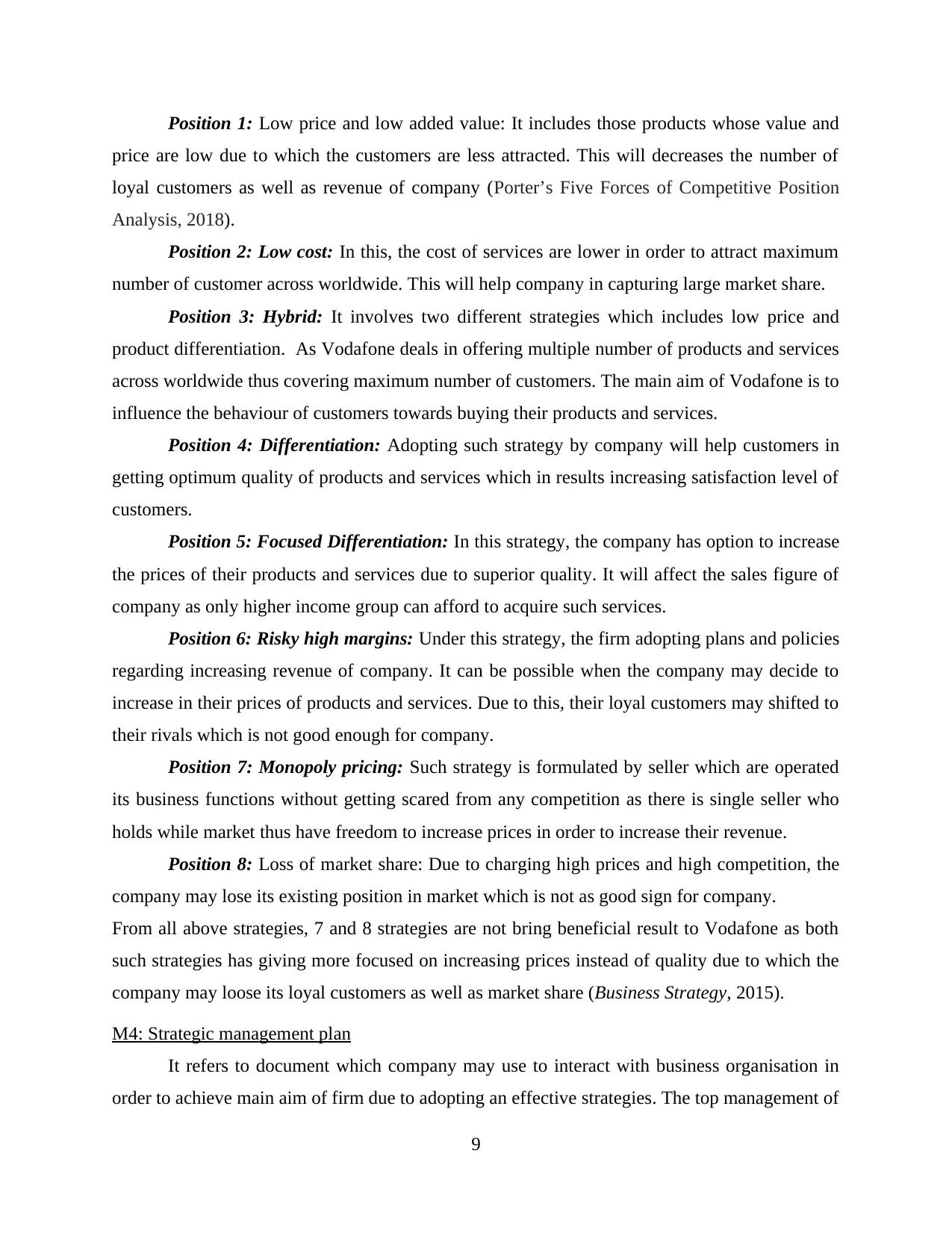
Position 1: Low price and low added value: It includes those products whose value and
price are low due to which the customers are less attracted. This will decreases the number of
loyal customers as well as revenue of company (Porter’s Five Forces of Competitive Position
Analysis, 2018).
Position 2: Low cost: In this, the cost of services are lower in order to attract maximum
number of customer across worldwide. This will help company in capturing large market share.
Position 3: Hybrid: It involves two different strategies which includes low price and
product differentiation. As Vodafone deals in offering multiple number of products and services
across worldwide thus covering maximum number of customers. The main aim of Vodafone is to
influence the behaviour of customers towards buying their products and services.
Position 4: Differentiation: Adopting such strategy by company will help customers in
getting optimum quality of products and services which in results increasing satisfaction level of
customers.
Position 5: Focused Differentiation: In this strategy, the company has option to increase
the prices of their products and services due to superior quality. It will affect the sales figure of
company as only higher income group can afford to acquire such services.
Position 6: Risky high margins: Under this strategy, the firm adopting plans and policies
regarding increasing revenue of company. It can be possible when the company may decide to
increase in their prices of products and services. Due to this, their loyal customers may shifted to
their rivals which is not good enough for company.
Position 7: Monopoly pricing: Such strategy is formulated by seller which are operated
its business functions without getting scared from any competition as there is single seller who
holds while market thus have freedom to increase prices in order to increase their revenue.
Position 8: Loss of market share: Due to charging high prices and high competition, the
company may lose its existing position in market which is not as good sign for company.
From all above strategies, 7 and 8 strategies are not bring beneficial result to Vodafone as both
such strategies has giving more focused on increasing prices instead of quality due to which the
company may loose its loyal customers as well as market share (Business Strategy, 2015).
M4: Strategic management plan
It refers to document which company may use to interact with business organisation in
order to achieve main aim of firm due to adopting an effective strategies. The top management of
9
price are low due to which the customers are less attracted. This will decreases the number of
loyal customers as well as revenue of company (Porter’s Five Forces of Competitive Position
Analysis, 2018).
Position 2: Low cost: In this, the cost of services are lower in order to attract maximum
number of customer across worldwide. This will help company in capturing large market share.
Position 3: Hybrid: It involves two different strategies which includes low price and
product differentiation. As Vodafone deals in offering multiple number of products and services
across worldwide thus covering maximum number of customers. The main aim of Vodafone is to
influence the behaviour of customers towards buying their products and services.
Position 4: Differentiation: Adopting such strategy by company will help customers in
getting optimum quality of products and services which in results increasing satisfaction level of
customers.
Position 5: Focused Differentiation: In this strategy, the company has option to increase
the prices of their products and services due to superior quality. It will affect the sales figure of
company as only higher income group can afford to acquire such services.
Position 6: Risky high margins: Under this strategy, the firm adopting plans and policies
regarding increasing revenue of company. It can be possible when the company may decide to
increase in their prices of products and services. Due to this, their loyal customers may shifted to
their rivals which is not good enough for company.
Position 7: Monopoly pricing: Such strategy is formulated by seller which are operated
its business functions without getting scared from any competition as there is single seller who
holds while market thus have freedom to increase prices in order to increase their revenue.
Position 8: Loss of market share: Due to charging high prices and high competition, the
company may lose its existing position in market which is not as good sign for company.
From all above strategies, 7 and 8 strategies are not bring beneficial result to Vodafone as both
such strategies has giving more focused on increasing prices instead of quality due to which the
company may loose its loyal customers as well as market share (Business Strategy, 2015).
M4: Strategic management plan
It refers to document which company may use to interact with business organisation in
order to achieve main aim of firm due to adopting an effective strategies. The top management of
9
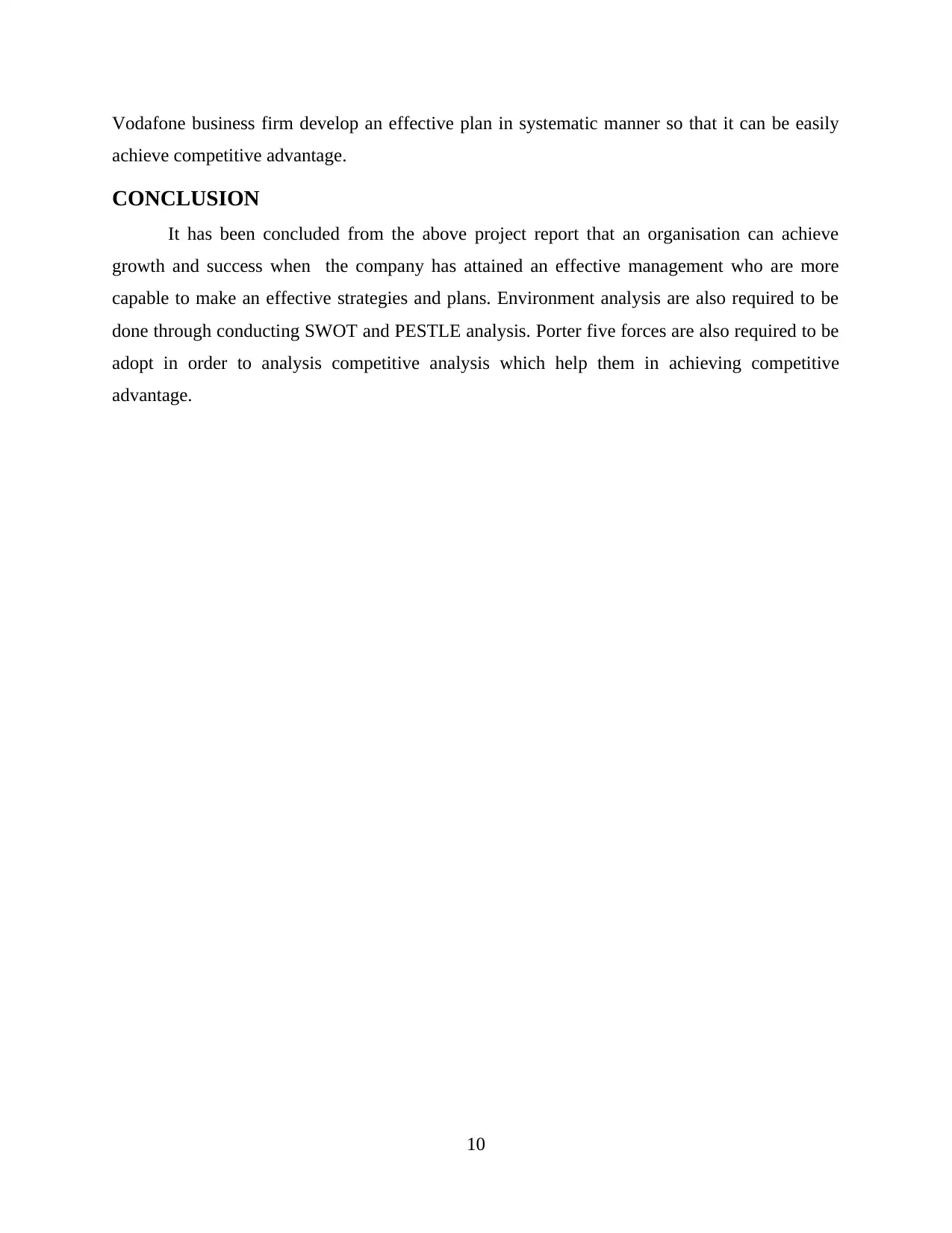
Vodafone business firm develop an effective plan in systematic manner so that it can be easily
achieve competitive advantage.
CONCLUSION
It has been concluded from the above project report that an organisation can achieve
growth and success when the company has attained an effective management who are more
capable to make an effective strategies and plans. Environment analysis are also required to be
done through conducting SWOT and PESTLE analysis. Porter five forces are also required to be
adopt in order to analysis competitive analysis which help them in achieving competitive
advantage.
10
achieve competitive advantage.
CONCLUSION
It has been concluded from the above project report that an organisation can achieve
growth and success when the company has attained an effective management who are more
capable to make an effective strategies and plans. Environment analysis are also required to be
done through conducting SWOT and PESTLE analysis. Porter five forces are also required to be
adopt in order to analysis competitive analysis which help them in achieving competitive
advantage.
10
⊘ This is a preview!⊘
Do you want full access?
Subscribe today to unlock all pages.

Trusted by 1+ million students worldwide
1 out of 13
Related Documents
Your All-in-One AI-Powered Toolkit for Academic Success.
+13062052269
info@desklib.com
Available 24*7 on WhatsApp / Email
![[object Object]](/_next/static/media/star-bottom.7253800d.svg)
Unlock your academic potential
Copyright © 2020–2025 A2Z Services. All Rights Reserved. Developed and managed by ZUCOL.





